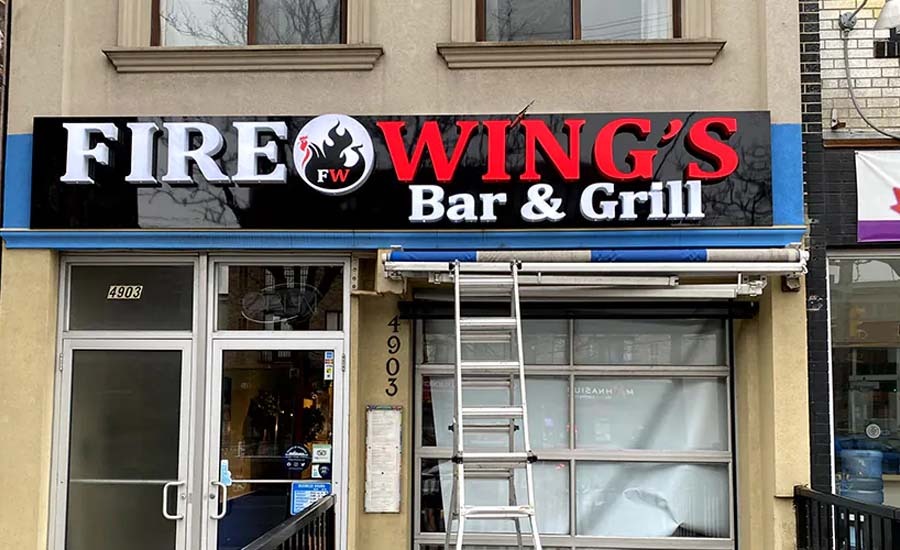
Storefront sign are displayed on the exterior of commercial and retail establishments. Storefront signs often include the establishment’s name, phrase or motto, logo, or all three to identify the company. Storefront signage can communicate other details like operating hours, a phone number, an address, etc., in addition to advertising sales.
If you run a business, you know the value of an excellent first impression. Often, potential clients may first encounter your business through your storefront sign. An eye-catching storefront sign may attract customers, communicate your brand’s message, and boost foot traffic and revenue. This post will cover ten crucial stages for creating an eye-catching and significant storefront sign. Achieving a lasting impact on your target market is essential.
Having an agency grasp of your company identity is crucial before constructing a storefront sign. What sort of company are you? What principles do you adhere to? What feelings do you wish to convey with your character? Responding to these questions can lay the basis for your character’s design.
Every effective sign addresses its target audience directly. Conduct in-depth research to determine your target population’s tastes, interests, and aesthetic sensibility. You may use this information to customize your design components so that they speak to potential buyers on a personal level.
The material selection can considerably impact the durability and appearance of your storefront sign. Choose durable materials that complement your company’s image and can survive various weather situations. The material should capture your company’s spirit, whether made of metal, wood, acrylic, or another substance.
If a sign is difficult to read, it is of little use visually. Choose legible fonts, proper sizes, and contrasting colors to ensure your message is understandable even from a distance. Always keep in mind that simple designs are frequently the most successful.
Your storefront sign should deliver a message that is both clear and captivating. Use convincing language that captures your brand’s value proposition and speaks to the requirements of your audience. A persuasive message has an influence that lasts.
In branding, consistency is essential. Continually incorporate the colors, logo, and other distinguishing features of your company into the design of the sign. It strengthens your brand identification and makes it simple to recognize your company.
Your shop sign’s location should be carefully considered. Examine the visibility of the area from various angles and distances. Your character should be visible to passing cars and pedestrians for maximum effect.
Test your design in various lighting and weather circumstances before finishing it. Get input from multiple people to gain understanding and make the required changes. The most significant effect of your sign is ensured through iterative testing.
When designing signs, striking the correct balance between text and images is essential. Use photos, graphics, and whitespace to improve the overall visual appeal without overpowering the viewer.
While DIY methods have advantages, hiring a professional sign designer may help your retail sign reach new heights. An experienced designer will ensure your character is strategically and aesthetically compelling by bringing knowledge about design principles, materials, and market trends.
If you follow these ten steps, you’ll be well on your way to creating an impactful storefront signs that stands out in the crowded market and connects with your target audience. Remember that your storefront sign represents the character and principles of your company, so put the time and effort into making it genuinely unique.
Remember that a thorough grasp of your brand identity and target market is the first step in the design process. It involves designing a sign that effectively conveys your distinctive value offer to anybody who sees it. The components—materials, typefaces, colors, and general layout—should all work harmoniously to give a unified message.
Creativity and readability must be balanced. A crowded sign with illegible typography and overpowering graphics may turn away potential consumers. Instead, use a design that effectively communicates your message so that everyone passing by may understand your services at a look.
Your sign’s practical location also significantly impacts how well it works. Its reach and effect will be increased by ensuring visibility from various perspectives and distances. Getting input from others and doing testing enable adjustments that lead to an optimum sign that can endure diverse circumstances.
While you may experiment with the design process independently, working with a qualified sign designer can provide outstanding results. Their experience may offer perceptions of business trends, design tenets, and material choices that may take time to be noticeable. They can help you realize your concept and create a magnificent reality that appeals to customers and strengthens your brand identification.
What color scheme should I use for my shop sign?
A1: Consider your brand’s colors and choose combinations with great contrast to make text easy to read.
Can I create my storefront sign without hiring a professional?
A2: Definitely! You can design a sign that supports your brand effectively with the correct resources and instructions.
How frequently should the design of my shop sign be updated?
A3: It’s a good idea to replace your sign anytime there are substantial changes to your company, but you can also maintain your brand appearing new with a refresh every few years.
What should I do if my storefront sign budget is tight?
A4: Pay attention to the fundamentals, such as clarity and simplicity. It’s okay for a sign to be highly complex to be effective.
How can I make my brand on the sign stand out more?
A5: Consider employing contrasting colors or backlighting to position your brand and bring attention to it strategically.